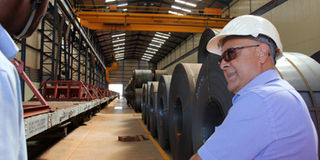Uganda’s manufactured goods exports increase

Iron sheets in a factory. Iron sheets are some of the manufactured products being exported from Uganda. PHOTO BY ABUBAKER LUBOWA
What you need to know:
The growth is partly attributed to the growing regional population, Dorothy Nakaweesi writes.
A decade ago, Uganda’s manufactured exports to the region were insignificant. Records now indicate a 100 per cent increase.
If this trend experts continues upwards, the country’s import bill will reduce drastically and more jobs will be created.
Currently, Uganda exports manufactured goods to the region worth $1 billion (Shs3.6 trillion) up from $10 million (Shs36.5 billion) the country earned almost 10 years ago.
Speaking to Prosper Magazine at the sidelines of the second Annual Exporters’ Conference, Mr Elly Twineyo, the executive director Uganda Export Promotion Board, said: “This trend shows that Uganda is diversifying from agro-based exports. The quality of our manufactured goods has improved greatly and with increased investment in value addition exports of manufactured goods have increased.”
Experts attribute this development to increased population in the region and people’s incomes, factors which have seen manufactured products especially under the construction sector highly demanded.
The products mainly demanded from Uganda are construction materials such as Cement, iron sheets and bars.
These mainly go to Western Kenya, South Sudan, Burundi and Rwanda, DR Congo plus some countries in the Comesa region.
Exporter’s view
Mr Oliver Lalan, the executive director of Roofings Uganda, which has been exporting iron sheets to the region, said: “The increase in manufactured exports is a positive move to promoting trade.”
Export trends
Latest export statistics from the Bank of Uganda as of November 2017 show that the country recorded exported goods and services (both formal and informal) worth Shs11.5 trillion, up from Shs9.8 trillion registered the previous year.
This indicated a Shs1.7 trillion increase but this performance is dwarfed by the huge import bill which around the same time had reached Shs20.8 trillion.
Supplementing on this trend, Private Sector Foundation Uganda’s, executive director, Mr Gideon Badagawa, said the multiplier effect of growth in manufactured exports is good for the economy in general.
“The multiplier effect of this growth will see jobs created for Ugandans will see the tax base widen because people’s incomes will increase and this will stimulate the local economy,” Mr Badagawa added.
He, however, said if the recent factors that are now impacting doing business like the high interest rates on loans, the instabilities in exchange rate are not worked on, the celebrated growth in the export of the manufactured products may be hampered.
Value addition
Uganda’s exports composition is mainly of agricultural products majority of which are exported in their raw or with little value addition.
The country’s leading export commodity-coffee which earned the Uganda $545 million (Shs1.9 trillion) last year is exported in its raw form, denying the country from earning a premium price at the international supermarket shelves.
Experts urge exporters to add value to all their products along the value chain.
Mr Twineyo said: “Adding value to your products or processing them will earn you and the country more money and this will also grow the local industries and the economy at a large.”
Exports to region
Manufactured goods exports. The products mainly demanded from Uganda are construction materials such as Cement, iron sheets and bars.
Changing trends. Trends are changing to manufactured exports of mainly construction products like Cement, Iron Sheets and Bars. Also other valued added products like Dairy Products and vegetable oils are breaking through the region.




